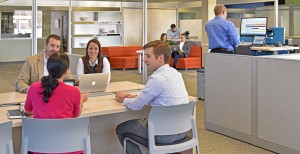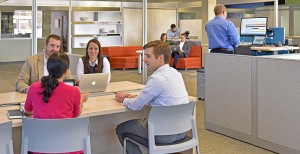Four Ways to Maximize Employee Work Output
11/18/2015

 Designing the ideal office layout has generated more interest over the last few years. While many companies are starting to promote walking meetings and sit-to-stand workstations, other factors must be considered as well. How seating is arranged, the amount of eye contact that can be achieved, and the distance between coworkers while communicating all affect an employee’s work output and are known as work ecology.
Designing the ideal office layout has generated more interest over the last few years. While many companies are starting to promote walking meetings and sit-to-stand workstations, other factors must be considered as well. How seating is arranged, the amount of eye contact that can be achieved, and the distance between coworkers while communicating all affect an employee’s work output and are known as work ecology.
To develop an ecological work space:
- Designate quiet zones for focused work. When a large project or a tight deadline comes down the pipeline, it’s important that employees have a private place to work. This type of work zone, be it a closed-door office or a designated “no phone” area, enables employees to focus and get the job done.
- Establish relational zones for small-group cooperation. Work often requires discussion with a colleague to discuss thoughts and ideas and to develop tactics. Provide seating where co-workers can sit next to one another, or at adjacent corners of a table, to promote conversation and “level the playing field” between them.
- Identify formal zones. Often, a central leadership figure mustinteract with an employee, host a visiting client, or entertain a prospect. Seating that enables two people, or two groups, to sit across from one another enhances the formality of the interaction, increases eye contact, and establishes a dominant figure in the conversation.
- Create open spaces to promote group collaboration. Working on large projects, brainstorming sessions, and business planning activities often requires input form many people. Provide an area for large-group discussions to increase the chance for a successful outcome. Circular or horseshoe-shaped tables, rather than long and rectangular ones, promote more equalized and open discussion. Additionally, provide alternative forms of seating, such as couches, lounge chairs, or even standing areas, to encourage employees to speak more boldly and enable their creativity to flow more freely.
Understanding how different work zones change individual or group interaction enables employers to optimize the work output of their employees.






